We were somewhere around Barstow on the edge of the desert when the drugs began to take hold. I remember saying something like “I feel a bit lightheaded; maybe you should drive…”
Thus begins Hunter Thompson’s defining masterwork, Fear and Loathing in Las Vegas; A Savage Journey to the Heart of the American Dream, and I tend to find myself thinking of that book whenever I’m riding through Barstow, but this time through it’s especially relevant. It’s almost exactly 40 years since the drug-soaked saga first saw print, serialized in the November and December 1971 issues of Rolling Stone under the pen name of Raoul Duke. It starts with that mad-assed dash from L.A. to Las Vegas along the very route I’m now riding, and the vehicle Thompson was driving was some Detroit muscle he referred to as The Great Red Shark. As fate would have it, I’m aboard an Ember Red Sunglo 2012 Road Glide Ultra which, with its signature shark-nose fairing, has no trouble adopting that very apt nickname.
There’s one other similarity operating here. Thompson was heading to Vegas to cover a motorcycle event for a magazine and so am I (his assignment was the Mint 400 desert race; mine is Las Vegas BikeFest). And there the similarities come to a screeching halt. Whereas he had a trunk stuffed with a veritable smorgasbord of mind-altering, soul-searing, mondo-partying substances, I’m packing sunscreen, multi-vitamins and the niacin that My Personal Nurse insists I ingest to keep my enviable cholesterol levels enviable. I hate my life.
I’m not particularly interested in the heart of the American dream, either. I have a much higher calling, I think, namely to discover, over the course of 1,500 miles, what manner of serious road beast is this latest iteration of the Road Glide, and whether it will change my stubborn bias against the breed.
To understand that bias you have to understand that in the world of full-fairing Harley touring machines, there are two distinct camps, the Bats and the Sharks, and that I’ve been an unabashed Bat. The Bats are fanciers of the looks and function of the venerable batwing fairing, first offered as an option on the 1969 Electra Glide, and the Sharks are all about the frame-mount twin-headlight unit that traces its roots to the 1980 Tour Glide. (It’s worth noting historically, that those two developments bookend the AMF era of Harley-Davidson.)
The Road Glide supplanted the Tour Glide, first appearing in 1998 with a decidedly different personality. No longer a full-boat dresser with a frankly ungainly fairing, it was now a high-style projectile of a bike, stripped of chrome rail ornamentation, stripped of its trunk and fairing lowers, and given a slim street-oriented saddle. The fairing was completely redesigned and given a vastly more aggressive and aerodynamic profile—and a new moniker, the shark nose.
The Shark clan was born that year, riders who were seduced by the model’s sleek appearance, relatively svelte curb weight, and by the superior handling properties of the frame-mount fairing, vis-à-vis the handlebar-mount batwing. Sharks would tend to be smug about it, even while grudgingly acknowledging the pronounced buffeting of the Shark heads caused by unchecked wind blast and other errant wind properties coming from the distant prow.
The schism that remains to this day likewise arose, with the Bats pronouncing the Road Glide an ugly affront to the Harley touring heritage, and the Sharks pronouncing the batwing an evil-handling anachronism. It’s an aesthetic thing, really, and a paradoxical one at that: Bats think Sharks are blind, and Sharks think Bats are hidebound.
The Sharks were crushed when their model abruptly disappeared in 2009, leaving only the slammed and eyebrow-screened Custom to carry the shark nose mystique forward. They were vocal to the point of apoplexy on the matter, seeing the move as the end of a grand era in sensible tourer design, but we know now that the failure to appear owed, not to a hard decision to lose the model, but to the simple fact that its successor, the Road Glide Ultra, wasn’t fully baked yet. With the debut of the Ultra last year, the full-boat dresser role returned to the model with the addition of a Tour Pak, fairing lowers, and plush operator and passenger accommodations.
The Ultra comes loaded with touring amenities. Electronic cruise control and antilock brakes are standard as is a Smart Security System. An 80-watt, four-speaker Harmon/Kardon audio system pumps out the tunes, though fidelity suffers somewhat from the distance between the front speakers and the rider, and the reach to the audio unit is a stretch for even the long-armed among us.
It’s all about the nose
My bias against the previous Road Glides owed somewhat to my Harley traditionalist streak and resulting fondness for the cut of the batwing, but primarily to the protective properties—or, rather, the lack thereof—of the shark nose. Being a tall rider, I experienced the head buffeting wind currents produced by the fairing more than most, but even shorter riders complained about it—so much so, in fact, that fortunes were made in the aftermarket selling replacement windscreens sculpted to diminish the phenomenon.
In designing the Ultra, the Milwaukee engineers were mindful of the moans and took some decisive steps to address it. The addition of fairing lowers is the most obvious, and it helps the cause appreciably, but beyond that they made a slight change in the windscreen angle and configuration, and also incorporated a pair of crash-bar-mounted baffle panels that effectively close the gap between the fairing and fairing lowers.
That may not sound like a whole lot of adjustments, but taken together the effectiveness in keeping the cockpit out of the blast is remarkable. Compared to the previous Road Glides, the Ultra is positively serene, and I spent most of my miles on the bike wearing just a half-shell helmet sans face shield and gleefully swiveling my head in sightseer mode—a practice that the previous Road Glides didn’t permit without running the risk of losing your glasses or your hearing.
Now that the wind is no longer the deal-breaker it was in the past, I’m able to fully appreciate the attributes of the shark nose in other areas, starting with the small spring-lidded storage cubbies located handily for on-the-fly access, and which when combined with the lower snap-closed compartments on the fairing lowers makes for a wealth of small item storage capacity. I also appreciate the instrument layout of the inner fairing. The gauges are at an easy-to-read distance and angle, and the whole constellation gives the cockpit an appealingly integrated appearance. The height of the windscreen is below your line of sight, unlike the Electra Glide’s batwing which needs to be replaced to get that desirable visibility.
And there’s simply no denying what the Sharks have been bragging about, i.e., the handling prowess of the machine. With the aerodynamics of the shark nose and the fact that the weight is borne by the frame instead of the front end optimizes both the admirable handling characteristics of the Touring chassis and the pulse-quickening punch of the Twin Cam 103 engine.
The only downsides remaining with the shark nose are only noticeable in slow speed maneuvering where the forward position and mass of the fairing require some finessing, and in the rain. Again, having the fairing that far out front means you can’t hunker down behind it, like you can with a batwing, and when I hit a frontal system and spent three hours in a steady rain I took a good vision-impairing soaking. The wind that does manage to invade the cockpit of the Ultra seems to come from all directions at once, frustrating efforts to escape the annoying spray of droplets.
Those are minor quibbles. The upshot here is that I’ve been mightily impressed with the touring performance of this machine. I’ve been evangelized, and find myself suddenly, surprisingly, a (shudder) Shark. To be perfectly clear, the batwing still takes the honors in overall wind and rain protection, as well as audio fidelity and ease of operating the sound system. But since I rarely make use of a sound system while riding, and the protection provided by the revised shark nose is more than adequate in most circumstances, those advantages are neutralized. The final determination comes down to the superior handling and acceleration of the Road Glide Ultra and, conclusively, the bike’s incredible fuel economy.
Over the 1,500 miles of widely varying conditions, The Great Red Shark delivered a somewhat astounding 46.2 mpg. Just prior to testing this bike, I’d put a similar 1,500 miles on a 2012 Electra Glide Ultra Classic and got an overall 41.8 mpg—fully 10 percent lower.
The 2012 Road Glide Ultra is available in Vivid Black for $22,499, and in Big Blue Pearl or the Red Ember Sunglo shown here for $23,074.


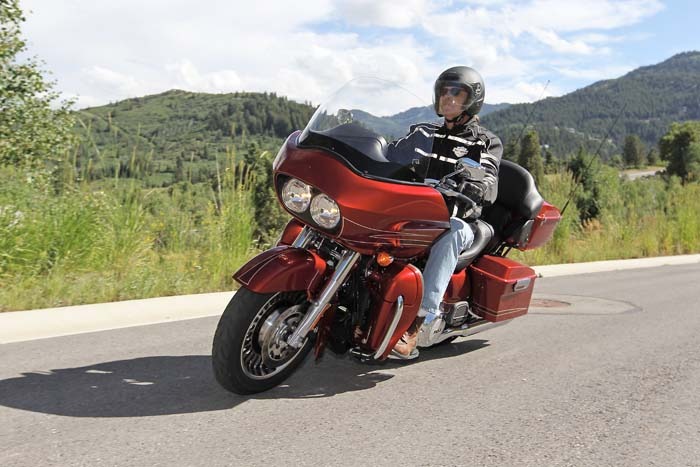
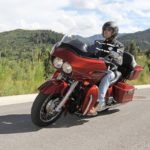
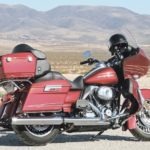

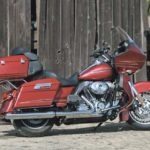
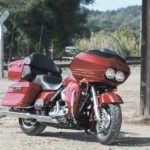
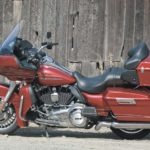
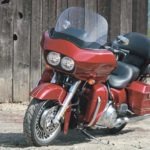
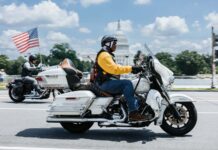















Thaanks for finally writing about >Harley-Davidson FLTRU Road Glide Ultra
2012 ride review | Thunder Press < Liked it!